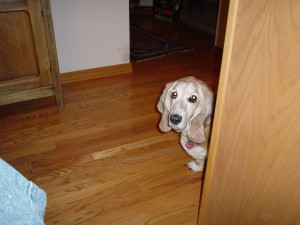The Swedish Definite Form – Demonstrative Pronouns Posted by Marcus Cederström on Mar 31, 2016 in Grammar
The Swedish language can be a bit tricky when working with the definite to describe something. As Stephen points out in “Why the double-definite in Swedish?” you’ll notice, if you haven’t already, that when you’re using an adjective to describe a noun in the definite form you’re going to double up on your definiteness. For example, to describe the brown dog you will say: den bruna hunden. To describe the red house say: det röda huset. To describe the brown dogs and the red houses say: de bruna hundarna och de röda husen. See how the definiteness gets doubled up? We use den, det, and de, as well as the definite articles on the end of the nouns. In fact, even the adjectives get a definite ending. The Swedish language wants to make sure that you definitely know you’re using the definite. (See what I did there? Cute, right?)
You do the exact same thing when you’re trying to describe this (den/det här), that (den/det där), these (de här), or those (de där). For example:
- this brown dog = den här bruna hunden
- this red house = det här röda huset
- these brown dogs and these red houses = de här bruna hundarna och de här röda husen
- those brown dogs and those red houses = de där bruna hundarna och de där röda husen
Once you get the hang of it, it’s not too bad. Want to describe something in the definite form? As a general rule, just make sure that you have a definite ending on your adjective, your noun, and that you include a definite “the” form. No problem.
But what about those pesky words denna, detta, and dessa? Denna, detta, and dessa are demonstrative pronouns that can be used to mean this and these. But they do something a little different to the noun.
Let’s say you want to write about this black car that you own. You could say: den här svarta bilen är min. You followed all the rules, you added den and här to show that it is this car. You added the definite ending to the adjective and to the noun. You did everything right. But there’s another way of saying that sentence. This black car is mine. Denna svarta bil är min. See what’s missing? The definite ending to the noun. It’s bil, not bilen. Same thing happens with detta and dessa:
- Detta röda hus är mitt.
- Dessa bruna hundar är mina.
Whenever you use a demonstrative pronoun like denna, detta, or dessa, you need to make sure that the adjective is in the definite form but that the noun is in the indefinite form. The same actually goes for possessive pronouns like min, hennes, sina (and all of the others), as well as the genitive form like Brors, Alles, bibliotekets (and every other person or place that might “possess” something). For example:
- Min stora bok.
- Brors roliga barn.
So now you know when you DON’T need to add that pesky definite ending to a noun, even if you’re describing something in the definite form. Good luck!
As Linn points out in a comment below, there are dialectical differences here, so you might still hear the occasional denna with a double definite.

Build vocabulary, practice pronunciation, and more with Transparent Language Online. Available anytime, anywhere, on any device.





Comments:
Linn:
Great post! One thing though… it’s “Detta röda hus är mitt”.
Something that I realized some years back (when someone from Sundsvall pointed it out) is that in Göteborg we actually do say e.g. “Denna svarta bilen”. I guess it’s a dialect thing!
Marcus Cederström:
@Linn Gah, of course the min, mitt, mina needs to match up with the rest of the sentence. Thanks for catching my mistake.
And you’re absolutely right, there are a few dialects that do the double definite with the denna!
Mats:
I can add that the double definite with denna is also said in Scania and Småland, so maybe it’s a Götaland/Southern Sweden thing. It’s not something you would write though, at least not in a somewhat formal text.
Marcus Cederström:
@Mats Very cool, thanks!
Selin:
Hejsan!
Hur kan man påpeka olikheten mellan “these” och “those” med “dessa”? Tack.